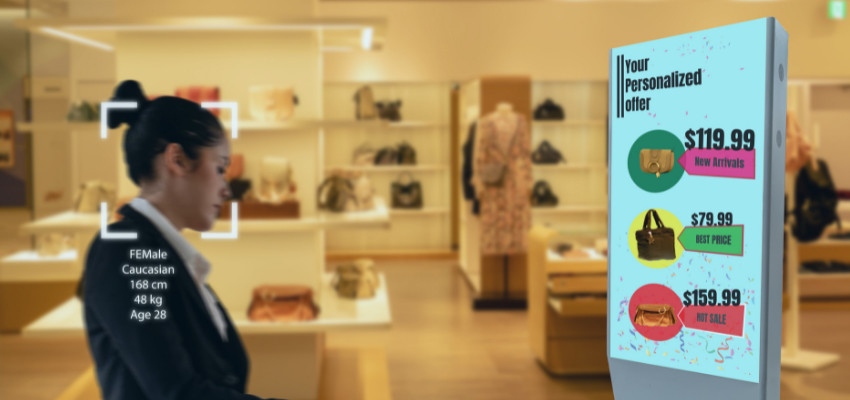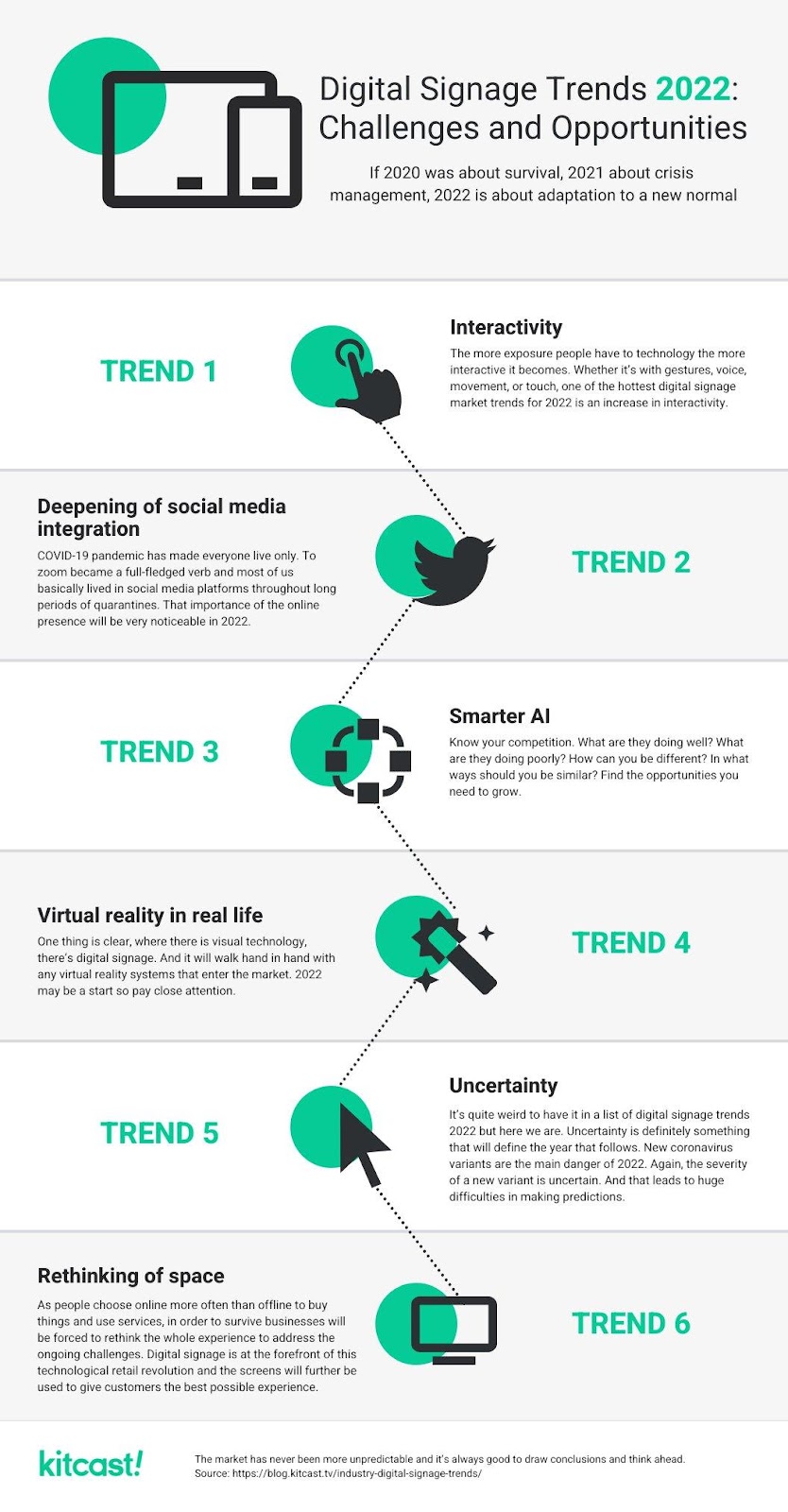Show:
Top Trends in Digital Signage Software: What’s Driving the Industry Forward
Digital signage has become an integral part of modern marketing and communication strategies for businesses of all sizes. As technology advances, so does the digital signage industry. In this article, we delve into the top trends in digital signage software that are shaping the industry’s future. From interactive displays to personalized content delivery, these trends are driving innovation and revolutionizing how businesses engage with their audiences.

Top Trends in Digital Signage Software
1. Interactive Displays for Enhanced Engagement
The shift towards interactive displays is a game-changer in the digital signage world. These displays use touch-screen technology to allow users to interact with content actively. From virtual product demonstrations to wayfinding maps, interactive displays create an immersive experience that captivates and engages audiences.

2. AI-Driven Content Personalization
Artificial Intelligence (AI) is transforming the way content is delivered on digital signage platforms. AI algorithms analyze user data and behavior to deliver personalized content tailored to individual preferences. This level of customization enhances the relevance of messages, leading to higher engagement and conversion rates.
3. Integration of Augmented Reality (AR)
Augmented Reality (AR) is gaining momentum in the digital signage space. By overlaying digital elements onto the physical world, AR provides a unique and interactive experience. Businesses are leveraging AR technology to create captivating advertising campaigns, entertainment experiences, and informative displays.
4. Cloud-Based Content Management
Cloud-based content management systems have simplified the way businesses handle digital signage content. This trend allows remote content updates, scheduling, and monitoring from anywhere, providing greater flexibility and ease of management.
5. Data-Driven Analytics for Performance Optimization
Data analytics play a vital role in optimizing digital signage campaigns. Advanced analytics tools gather data on audience demographics, behavior, and engagement. This valuable information helps businesses fine-tune their content strategy, ensuring maximum impact and return on investment.
Modern Platforms features can help take your Digital Signage to the next level, check LOOK digital signage software features in this video.
Other Platforms:
- OptiSigns
- Yodeck
- Rise Vision Digital Signage
6. Integration of Social Media Feeds
Digital signage is becoming more social-centric by integrating real-time social media feeds. Businesses are leveraging user-generated content to enhance engagement and build a sense of community around their brand.
7. Seamless Mobile Integration
Mobile integration has become crucial in digital signage campaigns. NFC, QR codes, and Bluetooth technology enable seamless interaction between digital signage displays and users’ smartphones, providing additional information or exclusive offers.
8. Sustainability and Energy Efficiency
The industry is moving towards eco-friendly and energy-efficient digital signage solutions. LED displays, low-power consumption, and smart sensors that adjust brightness based on ambient light contribute to reducing the environmental impact.
9. Integration of 5G Technology
The advent of 5G technology promises faster data speeds and low latency, revolutionizing digital signage experiences. With 5G, businesses can deliver high-definition content in real-time, ensuring a smooth and seamless user experience.
10. Integration of Beacons for Location-Based Targeting
Beacon technology enables businesses to deliver personalized messages to users based on their location. As individuals pass by a digital signage display, the beacon detects their presence and delivers relevant content, increasing the chances of engagement.
11. Video Wall Displays for Impactful Visuals
Video wall displays are gaining popularity as they offer larger-than-life visuals with high-resolution imagery. Businesses are leveraging these displays for impactful storytelling and captivating brand experiences.
12. Gesture and Voice Control
The incorporation of gesture and voice control technology in digital signage allows for touchless interactions, promoting a more hygienic and convenient experience, especially in public spaces.
13. Dynamic Content Scheduling
Dynamic content scheduling enables businesses to display specific content at pre-defined times or in response to real-time events. This ensures that audiences receive timely and relevant information.
14. Integration of QR Codes for Easy Access
QR codes provide a quick and easy way for users to access additional information or promotional offers by simply scanning the code with their smartphones.
15. Multi-Language Support for Diverse Audiences
In a globalized world, multi-language support on digital signage displays becomes crucial for catering to diverse audiences, making the content more inclusive and accessible.
16. Integration of Live Streaming
Live streaming on digital signage enables real-time communication, such as broadcasting events, seminars, or conferences, to a broader audience.
17. Gamification for Enhanced Engagement
Gamification elements, such as quizzes, contests, and rewards, encourage active participation and increase engagement with digital signage content.
18. Dynamic Content Personalization Based on Weather
Digital signage systems can adapt content based on the weather conditions, offering contextually relevant messaging and promotions.
19. Remote Device Monitoring and Troubleshooting
Remote device monitoring and troubleshooting capabilities enhance maintenance efficiency and minimize downtime for digital signage networks.
20. Transparent Displays for Futuristic Appeal
Transparent displays create a futuristic and eye-catching effect, merging digital content seamlessly with the physical environment.
21. Mobile Device Pairing for Personalized Experiences
Mobile device pairing enables personalized content delivery based on users’ smartphones or wearable devices.
22. Touchless Payment Integration
Digital signage systems with touchless payment options streamline transactions and enhance the customer experience in retail and hospitality settings.
23. Integration of Social Distancing and Safety Reminders
In the post-pandemic world, digital signage software is integrating safety reminders and social distancing notifications to ensure public health compliance.
24. Content Gamification for User-Generated Content
Businesses are incorporating content gamification to encourage users to create and share their content, fostering brand advocacy.
25. Remote Collaboration and Content Sharing
Remote collaboration tools allow multiple teams to contribute and share content effortlessly, fostering a streamlined content creation process.
FAQs
Q: How is AI driving content personalization in digital signage software?
A: AI algorithms analyze user data to deliver personalized content tailored to individual preferences, enhancing relevance and engagement.
Q: What are the benefits of integrating augmented reality in digital signage?
A: Augmented reality offers an interactive and immersive experience, enhancing engagement and leaving a lasting impression on viewers.
Q: How can businesses use data-driven analytics to optimize digital signage campaigns?
A: Data analytics help businesses gather insights into audience behavior, enabling them to fine-tune their content strategy for better results.
Q: What are the advantages of cloud-based content management for digital signage?
A: Cloud-based systems allow remote content updates and monitoring, providing greater flexibility and ease of management.
Q: How does 5G technology enhance digital signage experiences?
A: 5G promises faster data speeds and low latency, ensuring real-time and high-definition content delivery.
Q: How can businesses leverage gesture and voice control in digital signage?
A: Gesture and voice control technology enables touchless interactions, providing a hygienic and convenient experience for users.
Conclusion
The digital signage software industry is continuously evolving, driven by technological advancements and changing consumer preferences. From interactive displays and AI-driven content personalization to sustainability efforts and 5G integration, businesses are leveraging these top trends to deliver impactful and engaging experiences to their audiences. By staying abreast of these trends, businesses can unlock the full potential of digital signage and create memorable brand interactions in today’s dynamic world.

 Return to Previous Page
Return to Previous Page








